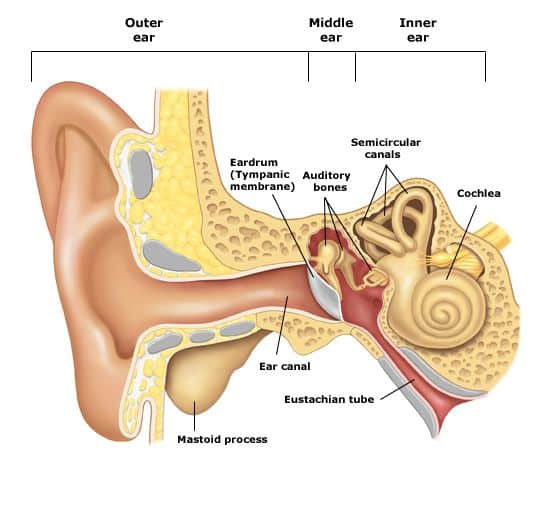How Hearing Works
Your ears are complex organs that are responsible for hearing, as well as spatial location and balance. Hearing keeps you safe when you’re driving to work or playing with your grandchildren in the park, and it allows you to have intimate conversations with the people you love the most. When all parts of the ear work together, you’ll have clear hearing, but when the ear is damaged, you’ll experience hearing loss. So how exactly does the ear work?
The auditory system is extremely complex, and the journey that carries sound waves to your brain is intricate. First, the outer ear channels the sound waves around you towards the middle ear, and acts as a natural amplifier to help you hear and locate all the sounds around you.
Next, the sound waves vibrate against the ear drum, or middle ear, causing three little bones in the middle ear to vibrate. This vibration causes movement in the fluid-filled inner ear, called the cochlea. As this fluid moves, tiny hair cells in the inner ear also move. These cells translate this movement into electrical signals, and send those signals to the brain, where the auditory center in your brain translates these signals so that you can hear.

Taking a Closer Look at the Ears
The Outer Ear
Hearing starts in the outer ear, or the part of the ear that you see. The ear has a number of ridges and folds, and these all help focus the sound towards your inner ear, and act as a natural amplifier to help you hear all the sounds around you with ease. The ear canal is also extremely important in directing the sound waves towards the inner ear, and the ear wax in the ear canal keeps your ear safe from dirt, dust, moisture, bacteria or infection. While you might think that ear wax is a bit gross, and do your best to remove this sticky substance, the truth is that ear wax plays an extremely important role in the health of your ear, and you should avoid excessively cleaning your ears.
The Middle Ear
Next the middle ear, also known as the tympanic membrane, creates a barrier between the outer ear and the inner ear. This part of the ear is a thin membrane that transmits the sound waves from the outer ear into the fluid filled middle ear, while providing protection to the delicate cells of the inner ear. In the middle ear are three tiny bones, known as the ossicles. They transmit the sound waves the hit the outer membrane of the middle ear, and create ripples in the fluid of the inner ear that match these sound waves.
The Inner Ear
Finally, the inner ear is where our ears sense sound. The fluid filled cochlea looks a bit like a snail, and this curved structure is responsible for translating sound waves into electrical signals that the brain can interpret. Hair cells line the walls of the cochlea, and they sense a huge range of sounds, from very low sounds like the rumble of distant traffic, all the way to high pitched sounds like a baby crying. These cells transmit this information along the auditory nerve to the auditory center of the brain, where your brain interprets these signals as sounds, and allows you to follow conversations, detect where sounds are coming from, and hear all the sounds around you.
Hearing Loss in the Inner Ear
The most common kind of hearing loss is known as sensorineural hearing loss, and it’s the result of damage to the delicate cells in the inner ear. When these hair cells are damaged, they aren’t able to sense the vibrations in the cochlea, or transmit these sounds to your brain. You’ll experience hearing loss in certain frequencies, depending on which hair cells have been destroyed. Sadly, once these cells are damaged, they don’t heal, and your hearing loss will be permanent. Sensorineural hearing loss is the result of exposure to loud noises, or happens as part of the normal aging process, as your ears experience the wear and tear of every-day life.
